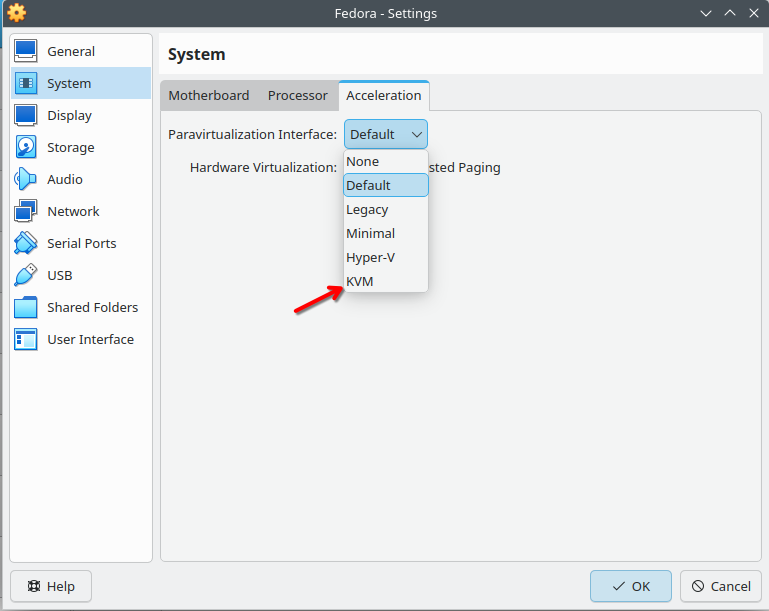Who cares. Why use sub par Type 2 virtualization with DKMS modules when you can use built+in world class, industry standard, Type 1 hypervisor with Qemu+KVM and Virt-Manager? Already has clipboard sharing with qemu-guest-agent.
vbox is easy. qemu is kinda frustrating to use sometimes, although virt-manager makes it a little easier
Virt-Manager provides a complete UI, with a four step wizard to creating a VM, how is vbox any easier?
Vbox will create a bridge with my wifi card (I’m a laptop user with no option for a wired nic in the host).
I’ve never been able to get kvm to do that and haven’t found any working instructions online that a simpleton like me can follow
Create the bridge with Network Manager advanced config, voilà!
vbox is easy until it starts saying vt-d isn’t enabled and refuses to start when it fact it is.
Because at least for me getting a shared folder to work was a total pain in the ass. Virtualbox just worked in that regard.
Again, just install qemu-guest-agent. You can even drag and drop files.
Because they are for different use cases. I use QEMU+KVM on desktop for games and 3D CAD software, because of its undeniable performance advantage. But on work laptop, I use VirtualBox to test my software on different platforms. On VirtualBox it’s relatively easy to initialize a VM, configure network, file sharing and device passthrough, and its snapshot feature allows me recreate the same environment for troubleshooting
All this is true using Virt-Manager… Especially if you use the qemu-guest-agent.
I just looked them up and maybe you are right. But QEMU definitely lacks a GUI config tool that is both easy to use and allows for advanced features like snapshots. So far the only ones I know is GNOME Boxes and Virt Manager, and neither is as good as providing handy ways to configure as VirtualBox. I could probably just write the XML config or QEMU command by the documentation, but next time it could be a different scenario so I have to investigate the docs and maybe a few more forum posts. In VirtualBox, the buttons that do everything for me are always there
But QEMU definitely lacks a GUI config tool that is both easy to use and allows for advanced features like snapshots.
Let me say it louder for the people in the back: https://virt-manager.org/
It literally does everything you mentioned, including allowing you to edit the XML files manually to reach advanced or obscure features that are not exposed. And it can do it remotely via SSH, and it managed LXC and Xen too.
Last time I tried Virt manager, I couldn’t figure out bridge networks and ended up corrupted the XML config for the VM. Skill issue for me I guess
Bridge networking should be as simple as selecting “bridge” in the network interface setting and putting the name of your bridge interface… You can create a bridge interface with Network-Manager. Or use macvtap.
Because for some reason, no matter what I try, Windows 10 desktop is laggy as hell on Qemu, and smooth out of the box on VirtualBox.
Are you using UEFI in Qemu?
Yeah, gotta have that and all that Secure Boot with TPM bullshit, because I’m visualizing a company workstation and nothing will work without those.
That’s all available in Qemu/OVMF yeah.
I think VBox is more user friendly? Virt-manager would need a GTK4 (?) update and a few UX improvements.
Certainly using a slightly dated Gtk is still more user friendly and better integrated than the god aweful stuff Oracle puts up. What UX improvements are you looking for?
I never got clipboard sharing working, on Fedora 40 KDE on Wayland. Probably a Wayland issue.
Doesn’t VirtualBox use KVM if it’s available?
I like
VBoxManage. Any crazy thing I’ve ever imagined doing with a VM it’s already supported.So, to answer your question - I use VirtualBox because it does everything I want and I’ve never had a reason to look elsewhere.
No, VBox does not use KVM unless you use some off brand backend, which is an extra layer of complexity and software you must install and manage.
Absolutely everything you might want to do with VBoxManager is going to be available via virsh and the multiple libviet utilities.
I’ve never had a reason to look elsewhere.
Not using Type 2 hypervisor would be a good one. Not being beholden to Oracle’s shitry licensing schemes is certainly another.

That’s using the externally developed Cyberus Technology backend though, like I mentioned. As mentioned all over this thread using extensions is rife for license abuse issues.
Use software owned by Oracle? Fuck that, I would rather get mauled by a bear.
Neat. As I am in the process of fully migrating to wayland, it is good. I only work as a teacher, so I don’t really concern about licensing, lol.
Maybe it can be installed in Debian 12 now without much trouble…






